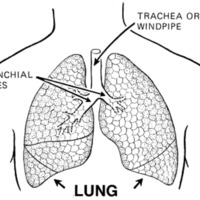Respiratory System
Dublin Core
Title
Description
The job of the respiratory system is to take oxygen from the air we breathe and get it to different parts of the body. Our bodies and the cells in them need oxygen (written with the chemical symbol O2) to live. Our cells give off carbon dioxide (written with the chemical symbol CO2) as a waste product or something they don’t need any more. The respiratory system takes this carbon dioxide out of the body.
The main organ of the respiratory system is the lungs. The respiratory system starts when you take a breath. There is a muscle called the diaphragm that is at the bottom of the rib cage. It helps draw air into the lungs.
Once a breath is taken, the air travels through the mouth or nose and travels through the windpipe into the lungs. Once the air is down the windpipe, it splits one of two directions into tubes called bronchi and then into the lungs. The bronchi branch off into more and more smaller tubes. At the very end of these are small sacs called alveoli.
In the alveoli, the respiratory system works with the circulatory system. Small blood vessels take oxygen from the alveoli to the heart for distribution to the rest of the body. Blood also brings carbon dioxide to be exhaled back out.
When we breathe in or inhale, the air coming into the body has a lot of oxygen. When we breathe out or exhale, the air has more carbon dioxide.
The main organ of the respiratory system is the lungs. The respiratory system starts when you take a breath. There is a muscle called the diaphragm that is at the bottom of the rib cage. It helps draw air into the lungs.
Once a breath is taken, the air travels through the mouth or nose and travels through the windpipe into the lungs. Once the air is down the windpipe, it splits one of two directions into tubes called bronchi and then into the lungs. The bronchi branch off into more and more smaller tubes. At the very end of these are small sacs called alveoli.
In the alveoli, the respiratory system works with the circulatory system. Small blood vessels take oxygen from the alveoli to the heart for distribution to the rest of the body. Blood also brings carbon dioxide to be exhaled back out.
When we breathe in or inhale, the air coming into the body has a lot of oxygen. When we breathe out or exhale, the air has more carbon dioxide.
Contributor
Cut Rita Zahara
Rights
Creative Commons
Type
Files
Collection
Citation
“Respiratory System,” Open Educational Resources (OER) , accessed January 21, 2026, http://oer.uinsyahada.ac.id/items/show/766.


